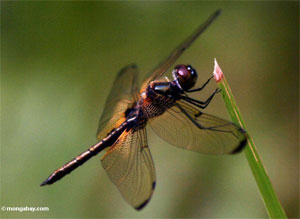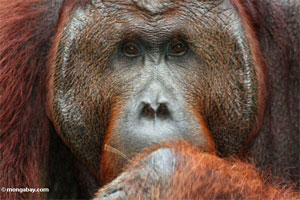16,119 species at risk of extinction
mongabay.com
May 2, 2006
The total number of known threatened species stands at 16,119 according to the World Conservation Union’s latest Red List, a tally of threatened and endangered species. The Geneva-based conservation group, known by its acronym IUCN, says that 784 species are officially extinct and that a further 65 are only found in captivity or cultivation. More than 40 percent of the 40,177 species assessed using the IUCN Red List criteria are considered at risk of going extinct, including one third the planet’s amphibians, one in four mammals, and about one in eight birds.
The IUCN Red List is considered the most authoritative assessment of the global status of plants and animals and is available online as a searchable database. The most recent update, the 2006 IUCN Red List of Threatened Species, will be unveiled Thursday.
“The 2006 IUCN Red List shows a clear trend: biodiversity loss is increasing, not slowing down,” said Achim Steiner, Director General of the World Conservation Union (IUCN). “The implications of this trend for the productivity and resilience of ecosystems and the lives and livelihoods of billions of people who depend on them are far-reaching. Reversing this trend is possible, as numerous conservation success stories have proven. To succeed on a global scale, we need new alliances across all sectors of society. Biodiversity cannot be saved by environmentalists alone — it must become the responsibility of everyone with the power and resources to act,” he added.
According to IUCN, mankind is behind most of the decline in global biodiversity through habitat destruction, the introduction of alien species, and overexploitation. Climate change is expected to have an increasingly important impact in the near future, especially for species found in cold ecosystems.
 Giant monkey frog (Phyllomedusa bicolor) in Peru, photo by Rhett Butler. The Red List says one in three amphibians worldwide is threatened with extinction. A study released earlier this year suggests that climate change is directly responsible for worsening infections caused by a skin fungus. This infectious disease — a type of chytrid fungus (Batrachochytrium dendrobatidis)—is now found in frog populations around the world and is the main suspect in the rapid disappearance of amphibians. Last year, the Global Amphibian Assessment, a survey of the planet’s amphibian species, found that nearly a third (32%) of the world’s 5743 known amphibian species are threatened and 129 species have gone extinct since 1980. Among the species to disappear is Costa Rica’s Golden toad (Bufo periglenes) and the Gastric Brooding Frog (Rheobatrachus silus) of Queensland, Australia. Scientists believe there may be around 10,000 amphibian species on the planet, although this number is likely to be falling fast. |
|
IUCN highlights the plight of polar bears as a case in point. In February, the U.S. Fish and Wildlife Service announced that it was considering a petition to list the polar bear as threatened under the Endangered Species Act due to the effects of global warming, specifically receding ice and rising temperatures. The loss of ice makes it more difficult for bears to find food — primarily seals. Further, the disappearance of summer sea ice could be taking a toll on swimming bears. Researchers report that drowned polar bears are being found for the first time in Alaska. Extrapolating from these developments, some scientists believe that polar bears could be extinct in the wild within the next century. Scientists estimate there are currently 20,000 to 25,000 polar bears world-wide and in its latest assessment IUCN lists the species as “Vulnerable”.
IUCN says that human impact extends to regions that would appear to be far removed from human influence, including deserts and dryland ecosystems. The organization cites the decline of the dama gazelle (Gazella dama) of the Sahara which has suffered an 80% population crash over the past 10 years due to hunting. The species has now been upgraded to Critically Endangered.
New to the 2006 Red List of Threatened Species is the first comprehensive regional assessment of selected marine groups, including sharks and rays, of which about 20 percent are threatened with extinction due to over-fishing.
“The plight of the angel shark (Squatina squatina) and common skate (Dipturus batis), once familiar sights in European fish-markets, illustrates dramatically the recent rapid deterioration of many sharks and rays,” says the report. “They have all but disappeared from sale. The angel shark (upgraded from Vulnerable to Critically Endangered) has been declared extinct in the North Sea and the common skate (upgraded from Endangered to Critically Endangered) is now very scarce in the Irish Sea and southern North Sea.”
 Brachydiplax dragonfly in Borneo, photo by Rhett Butler. The Red List says one third of assessed dragonflies are threatened with extinction. |
|
“Marine species are proving to be just as much at risk of extinction as their land-based counterparts: the desperate situation of many sharks and rays is just the tip of the iceberg,” said Craig Hilton-Taylor of the IUCN Red List Unit. “It is critical that urgent action to greatly improve management practices and implement conservation measures, such as agreed non-fishing areas, enforced mesh-size regulations and international catch limits, is taken before it is too late.”
Beyond the oceans, freshwater biodiversity is highly threatened. IUCN says that freshwater ecosystems have suffered some of the most dramatic declines, noting that 56 percent of the 252 endemic freshwater Mediterranean fish are threatened with extinction, the highest proportion of any regional freshwater fish assessment so far. The Red List reports that seven species, including carp relatives Alburnus akili in Turkey and Telestes ukliva from Croatia, are now Extinct.
Freshwater habitats are facing an onslaught of threats from deforestation, waterway modification and dam construction, the introduction exotic species, pollution, and over exploitation. Freshwater biodiversity is highly vulnerable. Habitats tend to be largely discontinuous meaning species cannot easily cross land barriers that separate lakes and watersheds. Thus freshwater fauna is generally localized, static, and subject changing conditions. Whereas terrestrial species simply migrate in response to habitat changes, freshwater species must cope with ecological and climatic changes in order to persist.
“We need fish for food, but human activities in watersheds, through forest clearance, pollution, water abstraction and eutrophication are major factors influencing water quality and quantity. This has a major impact on freshwater species, and in turn on the well being of riparian communities,” said Dr Jean-Christophe Vié, Deputy Coordinator, IUCN Species Programme.
The report continues, “as well as being an important source of food, freshwater ecosystems are essential for clean drinking water and sanitation. Over a billion people worldwide still do not have access to safe water. The continuing decline in wetlands and freshwater ecosystems will make it increasingly difficult to address this need and maintain existing supplies.”
IUCN says that with their semi-aquatic habitat, dragonflies are proving to be useful indicators of habitat quality above and below the water surface. Tellingly, of the 564 dragonfly and damselfly species so far assessed by the organization, nearly one in three are threatened, including nearly 40% of endemic Sri Lankan dragonflies.
Like dragonflies, amphibians — including frogs and salamanders — are often used for gauging the health of an ecosystem. These species too are rapidly declining, raising fears among ecologists that the global decline of amphibians may have broader implications for the world’s environment. Because amphibians have highly permeable skin and spend a portion of their life in water and on land, they are sensitive to environmental change and can act as the proverbial “canary in a coal mine,” indicating the relative health of an ecosystem. As they die, scientists are left wondering what plant or animal group is next.
Large freshwater species, such as the common hippopotamus (Hippopotamus amphibius) are also at risk according to the report. The Red List now classifies the hippo as Vulnerable, primarily as a result of a catastrophic decline in the population in Democratic Republic of the Congo where numbers have plummeted by 95% due to hunting for meat and the ivory of their teeth.
“Regional conflicts and political instability in some African countries have created hardship for many of the region’s inhabitants and the impact on wildlife has been equally devastating,” said Jeffrey McNeely, IUCN Chief Scientist.
 Orangutan in Borneo, photo by Rhett Butler. All the world’s great apes are under threat. Orangutans in Sumatra and Borneo are at risk of extinction due to poaching and habitat loss. |
|
Despite declining global biodiversity, IUCN is hopeful for the future. The organization says that its Red List of Threatened Species “acts as a wake up call to the world by focusing attention on the state of our natural environment. It has become an increasingly powerful tool for conservation planning, management, monitoring and decision-making. It is widely cited in the scientific literature as the most suitable system for assessing species extinction risk.” IUCN notes that 57 countries use national Red Lists, following IUCN criteria to focus their conservation priorities.
Further, says the organization, the Red List shows that conservation does work in that the status of certain species has improved after protective measures have been implemented. Specifically IUCN cites the move of the white-tailed eagle (Haliaeetus albicilla) from Near Threatened to Least Concern due to conservation action. Populations more doubled in the 1990s.
IUCN says that other species highlighted in previous Red List announcements are now the focus of conservation actions, which should lead to an improvement in their conservation status in the near future:
The 300 kg Mekong Catfish (Pangasianodon gigas) of South-east Asia is one of the largest freshwater fish in the world and was listed as Critically Endangered in 2003. Adopted as one of four flagship species by the Mekong Wetlands Biodiversity and Sustainable Use Programme, it is the focus of regional co-operation on fisheries management issues and conservation activities.
Swift action since the dramatic 97% population crash of the Indian Vulture (Gyps indicus), listed as Critically Endangered in 2002, means that the future for this and related species is more secure. The veterinary drug that unintentionally poisoned them, diclofenac, is now banned in India . A promising substitute has been found and captive breeding assurance colonies will be used for a re-introduction programme.
Many other species, such as the humphead wrasse (Cheilinus undulatus) (listed as Endangered since 2004), Saiga antelope (Saiga tatarica) (listed as Critically Endangered since 2002) are also the subject of concerted conservation campaigns.
“These examples show that conservation measures are making a difference,” concluded Achim Steiner. “What we need is more of them. Conservation successes document that we should not be passive by-standers in the unfolding tragedy of biodiversity loss and species extinction. IUCN together with the many actors in the global conservation community will continue to advocate greater investments in biodiversity and to mobilize new coalitions across all sectors of society.”
This article uses quotes and information from materials provided by IUCN